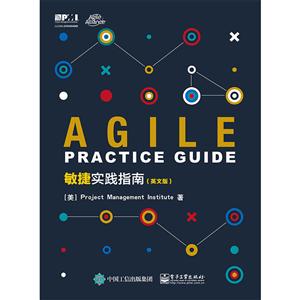-
>
麦肯锡极简工作系列(全3册)
-
>
近代华商股票市场制度与实践(1872—1937)
-
>
麦肯锡图表工作法
-
>
李诞脱口秀工作手册
-
>
熵增定律
-
>
富爸爸穷爸爸
-
>
李欣频的文案课
敏捷实践指南(英文版) 版权信息
- ISBN:9787121341069
- 条形码:9787121341069 ; 978-7-121-34106-9
- 装帧:一般胶版纸
- 册数:暂无
- 重量:暂无
- 所属分类:>>
敏捷实践指南(英文版) 本书特色
本书是美国项目管理协会新发布的敏捷实践标准,它是理解、评估和使用敏捷和混合的敏捷方法的资源。该实践指南为何时、何地以及如何应用敏捷方法提供指导,并为希望增强敏捷性的实践者和组织提供实用工具。本指南是与PMI其他标准一致,包括项目管理知识体系指南(PMBOK指南第六版),是PMI与敏捷联盟合作开发的成果,是PMI推出的敏捷认证教材之一。
敏捷实践指南(英文版) 内容简介
本书是美国项目管理协会新发布的敏捷实践标准,它是理解、评估和使用敏捷和混合的敏捷方法的资源。该实践指南为何时、何地以及如何应用敏捷方法提供指导,并为希望增强敏捷性的实践者和组织提供实用工具。本指南是与PMI其他标准一致,包括项目管理知识体系指南(PMBOK指南第六版),是PMI与敏捷联盟合作开发的成果,是PMI推出的敏捷认证教材之一。
敏捷实践指南(英文版) 目录
1. Introduction............................................................................................................................1
2. AN INTRODUCTION TO AGILE......................................................................................................7
2.1 Definable Work vs. High-Uncertainty Work......................................................................7
2.2 The Agile Manifesto and Mindset.....................................................................................8
2.3 Lean and the Kanban Method.........................................................................................12
2.4 Uncertainty, Risk, and Life Cycle Selection....................................................................13
3. LIFE CYCLE SELECTION.............................................................................................................17
3.1 Characteristics of Project Life Cycles.............................................................................18
3.1.1 Characteristics of Predictive Life Cycles...........................................................20
3.1.2 Characteristics of Iterative Life Cycles..............................................................21
3.1.3 Characteristics of Incremental Life Cycles........................................................22
3.1.4 Characteristics of Agile Life Cycles....................................................................24
3.1.5 Agile Suitability Filters........................................................................................25
3.1.6 Characteristics of Hybrid Life Cycles.................................................................26
3.1.7 Combined Agile and Predictive Approaches......................................................27
3.1.8 Predominantly Predictive Approach with Some Agile Components.................28
3.1.9 A Largely Agile Approach with a Predictive Component...................................28
3.1.10 Hybrid Life Cycles as Fit-For-Purpose..............................................................29
3.1.11 Hybrid Life Cycles as Transition Strategy........................................................30
3.2 Mixing Agile Approaches................................................................................................31
3.3 Project Factors That Influence Tailoring........................................................................32
4. IMPLEMENTING AGILE: CREATING AN AGILE ENVIRONMENT.................................................33
4.1 Start with an Agile Mindset............................................................................................33
4.2 Servant Leadership Empowers the Team.......................................................................33
4.2.1 Servant Leader Responsibilities.........................................................................34
4.2.2 Role of the Project Manager in an Agile Environment.......................................37
4.2.3 Project Managers Use Servant Leadership........................................................38
4.3 Team Composition...........................................................................................................38
4.3.1 Agile Teams.........................................................................................................39
4.3.2 Agile Roles...........................................................................................................40
4.3.3 Generalizing Specialists......................................................................................42
4.3.4 Team Structures..................................................................................................43
4.3.5 Dedicated Team Members..................................................................................44
4.3.6 Team Workspaces...............................................................................................46
4.3.7 Overcoming Organizational Silos.......................................................................47
5. IMPLEMENTING AGILE: DELIVERING IN AN AGILE ENVIRONMENT.........................................49
5.1 Charter the Project and the Team...................................................................................49
5.2 Common Agile Practices.................................................................................................50
5.2.1 Retrospectives.....................................................................................................50
5.2.2 Backlog Preparation...........................................................................................52
5.2.3 Backlog Refinement............................................................................................52
5.2.4 Daily Standups....................................................................................................53
5.2.5 Demonstrations/Reviews....................................................................................55
5.2.6 Planning for Iteration-Based Agile.....................................................................55
5.2.7 Execution Practices that Help Teams Deliver Value..........................................56
5.2.8 How Iterations and Increments Help Deliver Working Product.........................57
5.3 Troubleshooting Agile Project Challenges.....................................................................57
5.4 Measurements in Agile Projects.....................................................................................60
5.4.1 Agile Teams Measure Results............................................................................61
6. ORGANIZATIONAL CONSIDERATIONS FOR PROJECT AGILITY...............................................71
6.1 Organizational Change Management.............................................................................71
6.1.1 Drivers for Change Management........................................................................73
6.1.2 Readiness for Change.........................................................................................73
6.2 Organizational Culture.....................................................................................................75
6.2.1 Creating an Environment of Safety.....................................................................75
6.2.2 Assessing Culture...............................................................................................75
6.3 Procurement and Contracts............................................................................................77
6.4 Business Practices..........................................................................................................79
6.5 Multiteam Coordination and Dependencies (Scaling)...................................................80
6.5.1 Frameworks........................................................................................................80
6.5.2 Considerations....................................................................................................80
6.6 Agile and the Project Management Office (PMO)...........................................................81
6.6.1 An Agile PMO is Value-Driven.............................................................................81
6.6.2 An Agile PMO is Invitation-Oriented...................................................................81
6.6.3 An Agile PMO is Multidisciplinary......................................................................82
6.7 Organizational Structure.................................................................................................83
6.8 Evolving the Organization.................................................................................
敏捷实践指南(英文版) 作者简介
Project Management Institute(项目管理协会)是全球项目管理领域权威的非营利机构,致力于项目管理体系、方法的研究、应用与推广,其制定的“项目管理知识体系指南”已成为全球公认的项目管理标准。
- >
姑妈的宝刀
姑妈的宝刀
¥11.4¥30.0 - >
罗庸西南联大授课录
罗庸西南联大授课录
¥13.8¥32.0 - >
苦雨斋序跋文-周作人自编集
苦雨斋序跋文-周作人自编集
¥6.9¥16.0 - >
回忆爱玛侬
回忆爱玛侬
¥10.5¥32.8 - >
名家带你读鲁迅:故事新编
名家带你读鲁迅:故事新编
¥13.0¥26.0 - >
企鹅口袋书系列·伟大的思想20:论自然选择(英汉双语)
企鹅口袋书系列·伟大的思想20:论自然选择(英汉双语)
¥6.3¥14.0 - >
经典常谈
经典常谈
¥17.1¥39.8 - >
诗经-先民的歌唱
诗经-先民的歌唱
¥15.9¥39.8
-
IT项目经理成长手记-第2版
¥41.3¥59 -
新版一页纸项目管理(精装版)
¥54.6¥78 -
项目管理知识体系指南(PMBOK指南)(第6版)
¥111.7¥228 -
2022图书×抽奖盲袋
¥9.9¥25 -
2023读书月阅读盲盒——天黑,闭眼,刀谁?
¥42.3¥158















